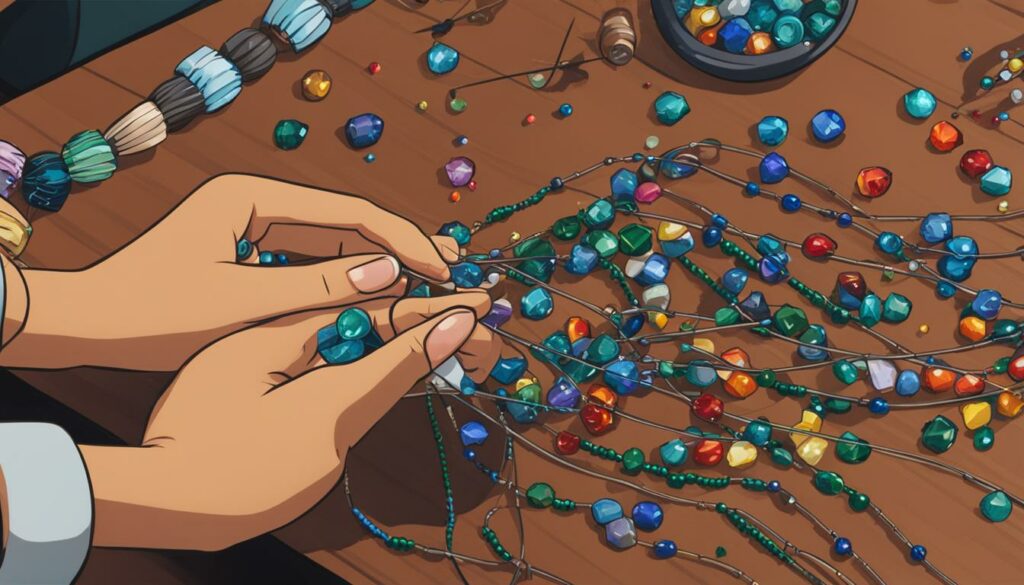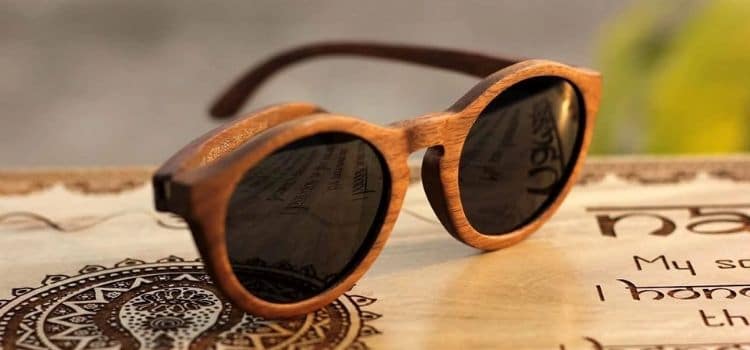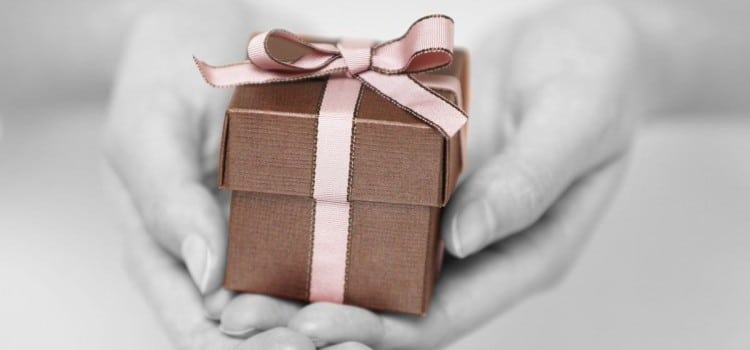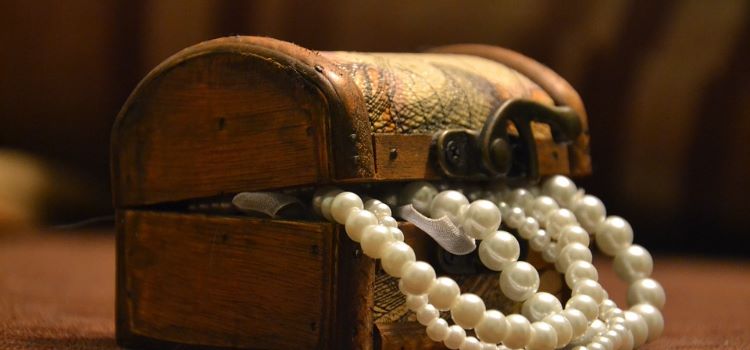Are you tired of your favorite necklace breaking? Don’t worry, I’ve got you covered! In this quick guide, I will show you how to fix a broken string necklace with ease. Whether it’s a cherished heirloom or a trendy piece, you can repair it yourself and save both time and money.
First, examine the break and assess if it can be reattached with a simple knot or if you need to cut it and add an end piece or clasp. Use needle-nosed pliers to hold the string securely while cutting it with sharp scissors. This ensures a clean cut without causing any further damage.
Next, grab your threading needles and attach the end piece or clasp onto the necklace. Thread the string through the needle’s eye and carefully weave it through the end piece or clasp, securing it tightly. Take your time and make sure it’s securely attached.
Finally, for that extra peace of mind, apply a coat of clear nail polish on part of the string before knotting it together. This provides added security and helps prevent future breakage.
And voila! Your broken string necklace is now good as new, and you can continue wearing it with confidence.
Remember, DIY necklace repair is not only satisfying but also saves you from buying a new necklace. So the next time your beloved necklace breaks, don’t fret! Follow these steps, and you’ll be amazed at how easily you can fix it yourself.
Are Necklaces Prone to Breaking Easily?
When it comes to the durability of necklaces, there are a few factors to consider. The type and quality of the necklace play a significant role in determining its vulnerability to breakage. Necklaces made with weak metals or poor craftsmanship are more prone to breaking. Lightweight pendants on thin chains and string necklaces are particularly susceptible to breakage. However, necklaces made from stronger materials, such as gold and diamonds, and those with clasp closures or reinforced seams, are generally more durable.
It’s important to note that while necklaces can break easily under certain circumstances, taking proper care of them can significantly extend their lifespan. Regularly inspecting and maintaining your necklaces will help prevent any potential issues and keep them in good condition for years to come.
“The type and quality of the necklace play a significant role in determining its vulnerability to breakage.”
Necklace Durability Factors
When assessing the durability of a necklace, it’s essential to consider the following factors:
- Material: Necklaces made from stronger materials, such as gold, silver, or stainless steel, tend to be more durable compared to those made from weaker metals.
- Craftsmanship: A well-crafted necklace with attention to detail and quality construction is less likely to break easily than one with poor craftsmanship.
- Design: Necklaces with clasp closures or reinforced seams are generally more sturdy and less prone to breakage than those with delicate chains or string.
By keeping these factors in mind and choosing necklaces made with durable materials and craftsmanship, you can minimize the risk of breakage and enjoy your jewelry for a long time.
Table: Necklace Durability Comparison
| Necklace Type | Durability |
|---|---|
| Gold Necklace | Durable |
| Silver Necklace | Moderately durable |
| Stainless Steel Necklace | Durable |
| Rhinestone Necklace | Less durable |
| String Necklace | Less durable |
Table Note: The table showcases the durability of various necklace types, with gold, silver, and stainless steel necklaces being the most durable, and rhinestone and string necklaces being less durable.
How to Fix a Broken String Necklace
If you have a broken string necklace, don’t worry! You can easily fix it yourself with a few simple steps. First, examine the break to determine if it can be reattached with a simple knot or if you need to cut the string and add an end piece or clasp. If a cut is necessary, use needle-nosed pliers to hold the string in place while cutting it with sharp scissors.
Next, use threading needles to attach the end piece or clasp onto the necklace. This will secure the broken ends together and ensure that the necklace stays intact. Finally, to add an extra layer of security, apply clear nail polish on the part of the string where the knot is formed. This will help prevent the knot from unraveling and keep your necklace in place.
By following these simple steps, you can fix your broken string necklace and continue wearing it with confidence. No need to spend money on expensive repairs when you can easily do it yourself!
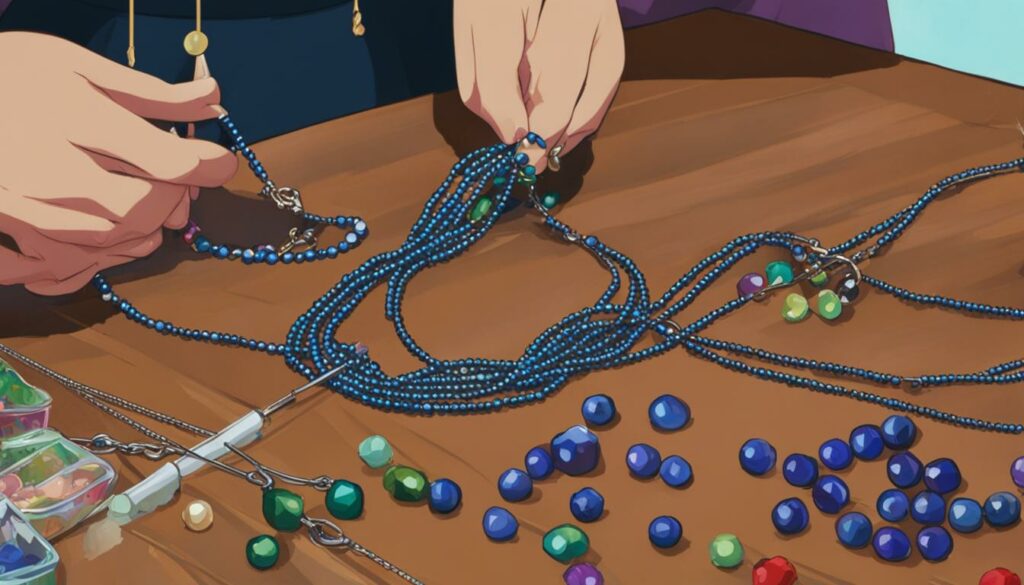
Tips for DIY Necklace Repair:
- Always use sharp scissors to ensure a clean cut.
- Choose a clear nail polish that dries quickly for faster results.
- Take your time when threading the end piece or clasp to ensure a secure attachment.
- Avoid pulling too tightly on the string to prevent it from breaking again.
- Inspect the repaired necklace regularly to check for any signs of wear and tear.
“With a little patience and the right tools, fixing a broken string necklace can be a simple and rewarding DIY project.”
Don’t let a broken string necklace keep you from wearing your favorite piece of jewelry. Follow these steps and give your necklace a new lease on life!
| Pros of DIY Necklace Repair | Cons of DIY Necklace Repair |
|---|---|
| Cost-effective | Requires some basic tools |
| Empowering to fix your own jewelry | May not be suitable for complex repairs |
| Saves time compared to waiting for professional repairs | Requires some level of manual dexterity |
Will a Gold Necklace Break Easily?
Gold necklaces are known for their durability and strength. Unlike delicate string necklaces or lightweight pendants, gold necklaces are designed to withstand everyday wear and tear without breaking easily. The sturdy nature of gold makes it a reliable choice for those seeking a long-lasting and resilient necklace.
While the gold itself is highly durable, it’s important to pay attention to the clasps used in gold necklaces. Clasps are the mechanisms that hold the chain together and secure the necklace around the neck. If the clasps become loose or damaged, it can cause the necklace to break apart. Therefore, regular inspection and maintenance of the clasps are crucial in ensuring the longevity of a gold necklace.
Investing in a high-quality gold necklace with secure and durable clasps is key to avoiding any potential breakage. Additionally, handling the necklace with care and avoiding activities that may strain or snag the necklace will contribute to its long-term durability. By taking these simple precautions, you can enjoy your gold necklace for years to come.
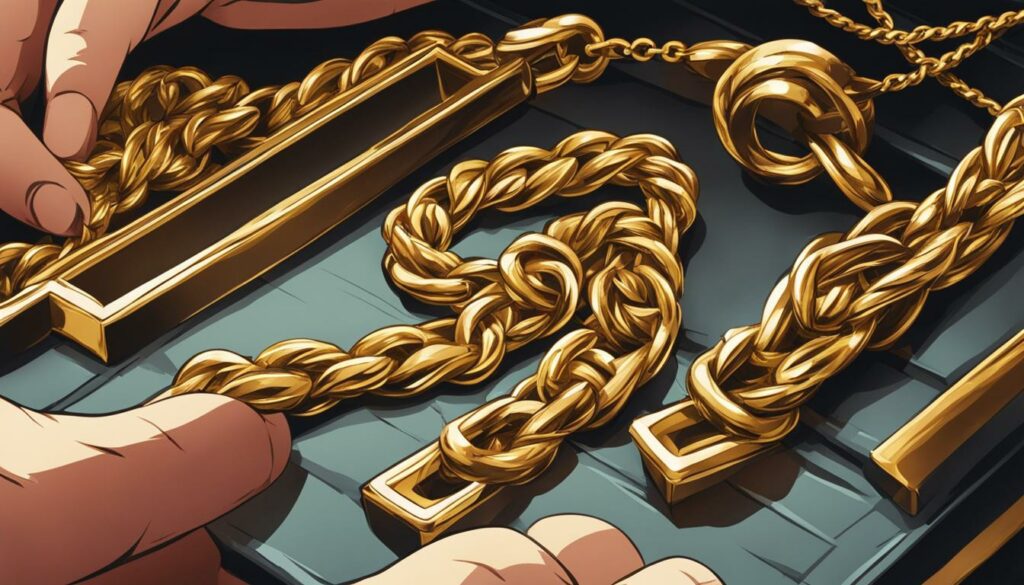
Table: Comparison of Necklace Durability
| Necklace Material | Durability |
|---|---|
| Gold | Highly durable, resistant to breakage |
| Silver | Moderately durable, more prone to tarnish and scratches |
| Platinum | Highly durable, resistant to tarnish and scratches |
| String/Thread | Less durable, prone to breakage or fraying |
How to Fix a Broken Gold Necklace
When it comes to fixing a broken gold necklace, a few simple steps can get your precious piece of jewelry looking good as new. Here’s a DIY guide to repairing your broken gold necklace:
Materials Needed:
- Jewelry pliers
- Jump rings
- Small patch of soft cloth
Follow these easy steps to repair your broken gold necklace:
- Open the jump rings using the jewelry pliers.
- Thread each end of the necklace onto one jump ring.
- Securely close the jump rings to connect the broken ends together.
- Place a small cloth around the connected ends for added protection.
By following these steps, you can fix your broken gold necklace and restore its beauty. However, if you’re unsure or uncomfortable with DIY repairs, it’s always best to seek professional assistance from a jeweler.
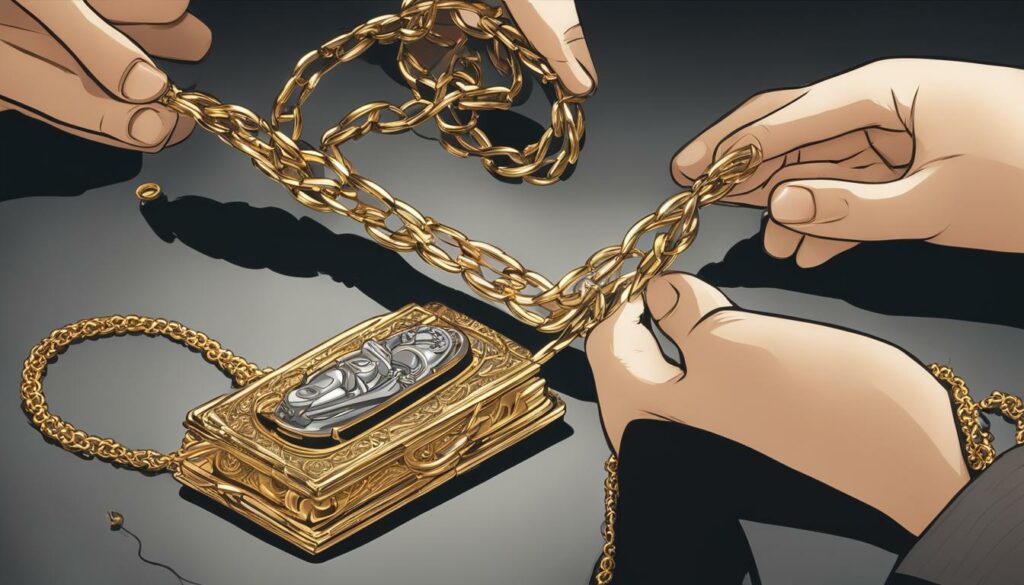
Table: Comparison of DIY Necklace Repair Methods
| Repair Method | Materials Needed | Level of Difficulty |
|---|---|---|
| Fixing a Broken String Necklace | Needle-nosed pliers, sharp scissors, threading needles, clear nail polish | Easy |
| Fixing a Broken Gold Necklace | Jewelry pliers, jump rings, small patch of soft cloth | Moderate |
| Mending a Broken Pendant Necklace | Replacement jump rings or clasps, jewelry pliers, cutters, extra links | Difficult |
Pendant Necklace Durability and Strength: What You Need to Know
When it comes to pendant necklaces, durability and strength are key factors to consider. The longevity of a pendant necklace depends on various factors, including the materials used and the craftsmanship. Pendant necklaces made from robust metals like gold and diamonds tend to be more durable and less prone to breakage. These materials offer greater strength and resilience, ensuring that your pendant necklace can withstand everyday wear and tear.
Quality pendant necklaces are crafted with attention to detail, ensuring that the components are securely attached. However, it’s important to note that pendant necklaces, particularly those with delicate chains, may still be susceptible to damage if not handled with care. Avoid activities that put excessive strain on the necklace, such as tugging or pulling, as these can weaken the chain or cause the pendant to become detached.
The choice of pendant necklace materials can also impact its durability. While gold and diamonds are known for their strength, other materials like sterling silver or plated metals are more prone to tarnishing or scratching over time. It’s important to consider your lifestyle and how you plan to wear the necklace when selecting the material. If durability is a top priority, opt for pendant necklaces made from solid gold or precious stones.
| Material | Durability | Strength |
|---|---|---|
| Gold | High | Excellent |
| Diamonds | High | Excellent |
| Sterling Silver | Medium | Good |
| Plated Metals | Low | Fair |
Table: Pendant Necklace Materials and their Durability and Strength
“Investing in a pendant necklace made from quality materials like gold or diamonds ensures that you have a durable piece of jewelry that can withstand the test of time.” – Jewelry Expert
Maintaining Your Pendant Necklace
Proper care and maintenance play a crucial role in preserving the durability and strength of your pendant necklace. Here are some tips to help you keep your necklace in pristine condition:
- Store your pendant necklace separately from other jewelry to prevent tangling and scratching.
- Avoid exposing your necklace to harsh chemicals, perfumes, or lotions, as these can tarnish or damage the materials.
- Regularly clean your pendant necklace with a soft cloth to remove dirt and oils that can accumulate over time.
- Inspect the chain and pendant for any signs of wear, such as loose links or damaged clasps, and have them repaired promptly.
By following these maintenance tips and selecting a pendant necklace made from quality materials, you can enjoy a durable and beautiful piece of jewelry that will last for years to come.
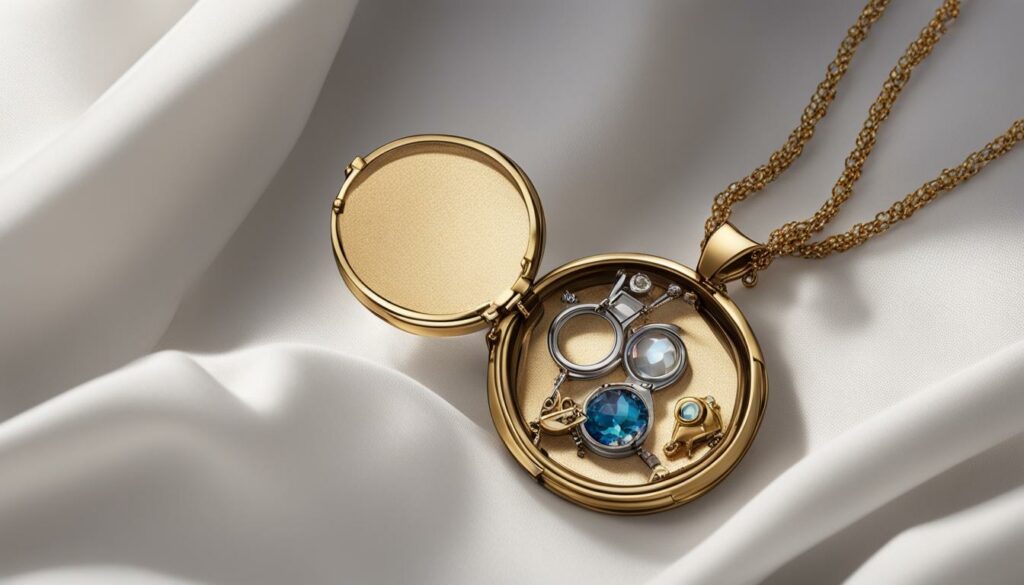
How to Mend a Broken Pendant Necklace
To mend a broken pendant necklace, there are a few simple steps you can follow. First, assess the damage and determine if any parts, such as jump rings or clasps, need to be replaced. You can find the necessary jewelry findings at craft supply stores or online. Once you have the replacement parts, begin by removing any broken or damaged components.
If the chain itself is broken, you will need jewelry pliers and cutters to remove the damaged section. Take care to cut the chain cleanly and evenly. Next, attach an extra link to each cut end using jump rings. This will reconnect the chain and restore its integrity. Make sure to close the jump rings securely with pliers to ensure a sturdy hold.
If the pendant itself is broken, you may need to consult a professional jeweler for repair. They will have the expertise and specialized tools to mend delicate or intricate pieces. They can also provide advice on how to prevent similar damage in the future.
| Step | Description |
|---|---|
| 1 | Assess the damage and determine if any parts need to be replaced. |
| 2 | If the chain is broken, use jewelry pliers and cutters to remove the damaged section. |
| 3 | Attach an extra link to each cut end using jump rings to reconnect the chain. |
| 4 | If the pendant is broken, consult a professional jeweler for repair. |
By following these steps, you can mend a broken pendant necklace and continue to enjoy wearing it for years to come. Remember to handle your necklace with care to prevent further damage and consider storing it in a safe place when not in use.
How to Prevent Necklaces from Breaking
When it comes to keeping your necklaces in pristine condition, there are a few simple tips you can follow to prevent breakage and ensure their longevity.
First and foremost, proper storage is key. Store your necklaces securely in individual boxes or soft cloth bags to prevent tangling and rubbing against other jewelry. This will help protect delicate chains and pendants from unnecessary strain and potential damage.
Additionally, it’s essential to handle your necklaces with care. Always remember to unclasp them gently when removing them, as tugging or pulling can put excessive stress on the chain and increase the risk of breakage.
Another important consideration is avoiding exposing your necklaces to moisture. Remove them before showering or bathing to prevent potential damage, as water can weaken the integrity of the materials over time.
Regular inspection is also crucial in preventing breakages. Take a close look at your necklaces periodically to check for any signs of wear and tear, such as loose or breakable links, clasps, or cracked beads. Addressing these issues early on can help you avoid further damage and costly repairs.
| Tips to Prevent Necklace Breakage |
|---|
| Store necklaces separately in individual boxes or soft cloth bags to avoid tangling and rubbing against other jewelry. |
| Handle necklaces with care, gently unclasp them when removing to avoid strain on the chain. |
| Avoid showering or bathing with necklaces to prevent moisture damage. |
| Regularly inspect necklaces for signs of wear and tear, such as loose links or cracked beads. |
By following these simple necklace care tips, you can keep your favorite necklaces looking beautiful and intact for years to come.
Conclusion
When it comes to fixing broken necklaces, durability is a key factor to consider. Whether it’s a delicate string necklace, a stunning gold necklace, or an elegant pendant necklace, the repair process can be accomplished with a few simple tools and some DIY knowledge. By taking proper care of your necklaces and following these repair tips, you can keep them looking beautiful for years to come.
Ensuring the longevity of your necklaces starts with understanding their construction and quality. While some necklaces may be more prone to breakage, others, like those made with strong materials such as gold or diamonds, are more durable. Regularly inspecting your necklaces for signs of wear and tear, like breakable links or cracked beads, can help you address any issues before they become major problems.
When a necklace does break, you can try fixing it yourself by using tools like needle-nosed pliers and threading needles. Cut the string carefully, add an end piece or clasp if necessary, and secure it with a knot. For gold necklaces, jewelry pliers and jump rings can help repair broken ends. If you’re not confident in your DIY skills, don’t hesitate to seek assistance from a professional jeweler.
Remember, prevention is always better than a cure. Take care of your necklaces by storing them securely, unclasping them when not in use, and avoiding activities that may strain or damage them. By following these simple tips and taking care of your necklaces, you can enjoy wearing them for years to come without worrying about frequent breakages.
FAQ
How do I fix a broken string necklace?
To fix a broken string necklace, first examine the break and determine if it can be reattached with a simple knot or if you will need to cut it and add an end piece or clasp. If cutting is necessary, use needle-nosed pliers to hold the string while cutting with sharp scissors. Then, use threading needles to attach the end piece or clasp onto the necklace. Finish off the repair by applying clear nail polish on part of the string before knotting it together for extra security.
Are necklaces prone to breaking easily?
The durability of a necklace depends on the type and quality of the necklace. Necklaces made with weak metals or poor craftsmanship are more prone to breaking. Lightweight pendants on thin chains and string necklaces are particularly susceptible to breakage. However, necklaces made from stronger materials such as gold and diamonds and those with clasp closures or reinforced seams are more durable.
Will a gold necklace break easily?
Gold necklaces are extremely strong and do not break easily. However, if the clasps that hold the chain together come loose, it can lead to the necklace breaking apart. It is important to check the clasps regularly and ensure they are secure.
How do I fix a broken gold necklace?
To fix a broken gold necklace, you will need jewelry pliers, jump rings, and a small patch of soft cloth. Open the jump rings using the pliers and thread each end of the necklace onto one jump ring. Securely close the jump rings to connect the broken ends together. Place a small cloth around the connected ends for added protection. This will help repair the necklace and keep it looking good as new.
Will pendant necklaces break easily?
Pendant necklaces can be quite resilient when handled with care. Quality pendant necklaces made from robust metals like gold and diamonds are less likely to break easily. However, it is important to avoid activities that cause excessive strain on the necklaces and to keep them well-maintained to ensure longevity.
How do I mend a broken pendant necklace?
To mend a broken pendant necklace, you may need to replace a jump ring or clasp if they are missing or broken. Replicas of these jewelry findings can be found at craft supply stores. If the chain itself is broken, you will need jewelry pliers, cutters, and extra links to reattach the split ends. Alternatively, you can seek professional assistance from a jeweler to repair the necklace.
How can I prevent necklaces from breaking?
To prevent necklaces from breaking, store them securely in individual boxes or bags to avoid tangling and rubbing against other jewelry. Always unclasp necklaces when removing them to prevent strain. Avoid showering or bathing with necklaces to prevent moisture damage. Regularly inspect necklaces for signs of wear and tear, such as breakable links or cracked beads. Taking proper care and caution with necklaces can help ensure their longevity.
Can I fix a broken necklace myself?
Fixing a broken necklace, whether it is a string necklace, gold necklace, or pendant necklace, can be done with some basic tools and DIY know-how. It is important to consider the type and quality of the necklace when determining its durability. Taking proper care of necklaces, such as storing them securely and inspecting them regularly, can help prevent breakages. By following these tips, you can enjoy your necklaces for years to come.
Source Links
- https://www.ifixit.com/Guide/How to Fix a Broken Necklace Chain/40180
- https://www.wikihow.com/Restring-a-Necklace
- https://didoshjewellery.com/blogs/journal/do-necklaces-break-easily-types-and-how-to-fix-them
